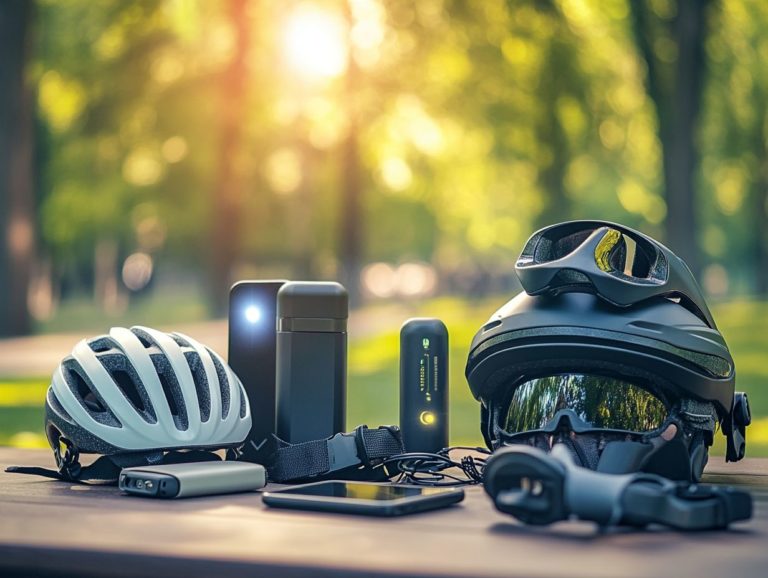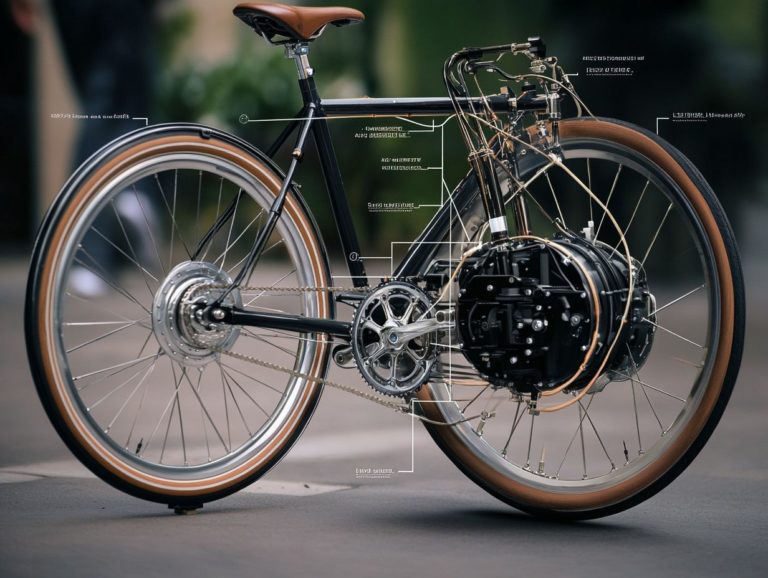Top Factors to Consider When Buying an E-Bike
Considering the purchase of an e-bike? You re certainly in good company these electric marvels are rapidly gaining traction for commuting, recreation, and a myriad of other adventures.
With a plethora of options available, it can feel daunting to pinpoint the ideal model for your specific needs. You’ll want to think about your budget, the type of motor, battery life, and any extra features that might enhance your riding experience.
Get ready to dive into this guide that will help you find your perfect e-bike!
Contents
- Key Takeaways:
- Top Factors to Consider When Buying an E-Bike
- 1. Budget
- 2. Type of Motor
- 3. Battery Life and Range
- 4. Weight and Size
- 5. Frame Material
- 6. Suspension System
- 7. Braking System
- 8. Speed and Power
- 9. Pedal Assist Levels
- 10. Display and Controls
- 11. Additional Features
- 12. Maintenance and Repairs
- 13. Warranty and Customer Support
- 14. Test Ride and Reviews
- 15. Personal Needs and Preferences
- Frequently Asked Questions
Key Takeaways:

- Consider your budget carefully when purchasing an e-bike as prices can vary widely.
- Research and choose the type of motor that best suits your needs and preferences.
- Look for a battery with a longer life and range to ensure your e-bike meets your distance requirements.
Top Factors to Consider When Buying an E-Bike
Choosing the perfect electric bike is essential for urban commuting. There are several key factors that can significantly elevate your cycling experience. From budget constraints to motor specifications and battery options, understanding these elements is crucial. This knowledge enables you to make an informed decision that truly aligns with your personal needs, especially in urban environments where alternative transport options are increasingly favored for their health benefits and positive environmental impact.
Choosing an e-bike isn’t merely about picking a stylish model; it’s about finding the right balance between cost-effectiveness and functionality. For those mindful of budgets, various e-bike models such as folding bikes that excel in storage convenience or robust commuter electric bicycles designed for durability can greatly influence your choice. Recognizing the long-term health advantages, like enhanced fitness and lower stress levels, underscores the importance of selecting the right model.
It’s vital to consider each e-bike’s environmental impact, as opting for electric over traditional vehicles reflects a commitment to sustainability and a greener future.
1. Budget
Setting a budget is essential when you’re in the market for an electric bike. With prices varying dramatically across different e-bike models, your budget directly influences the overall experience and features available to you.
E-bikes typically range from approximately $500 for basic models, which come with minimal features, to well over $5,000 for premium versions that boast cutting-edge technology and advanced components.
At the more affordable end, simpler designs are perfect for casual rides. Mid-range options usually offer better battery life and enhanced durability, striking a balance between cost and functionality.
For those willing to invest more, higher-priced e-bikes generally deliver superior performance, including faster speeds and advanced suspension systems, ideal for serious enthusiasts. Understanding the 5 key differences between e-bike types can help you choose the right model. Choosing an e-bike can lead to significant long-term savings, as reduced commuting costs and health benefits like improved fitness often outweigh the initial investment.
2. Type of Motor
The type of motor in your electric bike significantly influences your cycling experience. You can choose between hub drive (a motor located in the wheel hub) and mid drive systems, each offering unique advantages think efficient torque transfer and varied pedal assist levels.
Understanding these differences allows you to make choices that align with your needs. Hub drive motors provide straightforward installation and a whisper-quiet ride. Mid drive motors, located at the bike’s crank, facilitate better weight distribution and superior torque, particularly when tackling steep climbs.
Mid drive systems often feature integrated torque sensors that adjust power output based on your effort, enhancing the bike’s responsiveness. If you’re an urban commuter, you’ll likely appreciate the versatility of mid drive systems, as they excel at handling the varied terrain and stop-and-go nature of city riding, making them an ideal choice for navigating urban landscapes.
3. Battery Life and Range
When selecting an electric bike, battery life and range are key factors you can’t overlook. They dictate how far you can travel on a single charge, significantly impacting your daily commuting routine and overall satisfaction.
Understanding this is key, especially when it comes to battery technology. Lithium-ion batteries are particularly noteworthy. These powerhouses provide enhanced storage capabilities, allowing you to maximize your travel distances.
To assess battery capacity effectively, pay attention to metrics like the watt-hour rating, which reveals how much energy the battery can store, along with the bike’s energy consumption per mile.
For urban commuters like you, a balanced approach to battery life and range ensures you can tackle daily errands or longer rides without worrying about needing to recharge.
You can extend battery health by practicing regular maintenance and adopting mindful charging habits, ultimately leading to a more enjoyable riding experience.
4. Weight and Size
The weight and size of an electric bike greatly impact your decision, especially for urban commuting. Ease of transport and storage can elevate your cycling experience.
Different models, whether folding bikes or traditional designs, come in a variety of weights and dimensions tailored to your specific needs. For example, folding e-bikes are typically lighter and more maneuverable, making them perfect for city dwellers who need efficient storage solutions in compact spaces or while using public transport. To help you choose the best option, consider these 5 tips for selecting the right electric bike type.
Larger e-bike models might boast a greater weight capacity, but they can challenge your agility in bustling urban settings. Understanding the weight limits of these bikes is essential for ensuring safety and performance. For more guidance, consider choosing the right electric bicycle for your needs, particularly when carrying extra cargo or passengers.
5. Frame Material

Choosing the right frame material for your electric bike is crucial for optimizing your cycling experience. It directly impacts weight, durability, and ride comfort.
You might find the decision overwhelming, given the options available, each with unique characteristics. For example, aluminum is popular among many riders for its lightweight nature and corrosion resistance, making it an excellent choice for those seeking agility and performance across various terrains.
Carbon fiber offers remarkable stiffness and shock absorption for a smoother ride, though it often comes with a hefty price tag and may not endure impacts as well.
Steel, while heavier, provides classic strength and flexibility, making it particularly good for durability and comfort on long-distance rides.
Ultimately, grasping how each material influences both handling and enjoyment enables you to make well-informed choices.
6. Suspension System
A quality suspension system on your electric bike is essential for enhancing your cycling experience. It absorbs shocks and provides stability, especially when navigating varied terrains.
Different types of suspension systems cater to diverse needs. Front suspension smooths out bumps and dips, ideal for dodging potholes and curbs in busy city streets.
Full suspension offers comprehensive shock absorption, invaluable on rough surfaces. This enhances comfort and significantly improves control, helping you maintain balance and maneuver with ease.
In the dynamic landscape of urban riding, where terrain can change unexpectedly, understanding these suspension systems profoundly impacts your experience, ensuring a safe and enjoyable ride.
Make an informed decision and choose the right electric bike to elevate your cycling adventures!
7. Braking System
The braking system of your electric bike is essential for safety and control. It directly influences your ability to stop and maneuver effectively in various riding conditions.
Among the many choices available, disc brakes are often preferred for their exceptional stopping power and reliability in adverse weather. They excel in urban commuting, providing consistent performance even in rain or mud.
On the other hand, rim brakes are typically lighter and easier to maintain, but they may not offer the same level of grip in challenging conditions, which can compromise your safety.
Choosing the right braking system can transform your ride and keep you safe! Reliable brakes can significantly reduce the risk of accidents and boost your overall riding confidence in urban areas, especially as the e-bike revolution gains momentum.
8. Speed and Power
Understanding the speed and power options of your electric bike is crucial. These factors dictate how swiftly you can travel and how effectively the bike responds to your pedaling, especially regarding motor position.
The type of motor you choose significantly influences your desired acceleration and overall power delivery. For example, a mid-drive motor, located at the bike’s center, offers impressive torque and can leverage the bike’s gear system, making it perfect for hilly terrains. Conversely, hub motors provide a smoother ride, excelling at maintaining higher speeds on flat surfaces critical for urban commuting. When selecting an electric mountain bike, consider the 5 features to look for to enhance your riding experience.
As a rider, consider the balance between speed and energy efficiency. Higher speeds can lead to quicker battery depletion, so finding this equilibrium is vital for enjoying longer rides without sacrificing performance. For more insights, check out how to choose an electric bicycle type for you, especially when evaluating battery range.
9. Pedal Assist Levels
The pedal assist feature in electric bikes allows you to customize your cycling experience. It offers a range of support tailored to your effort and preferences, thanks to advanced torque sensors.
These sensors detect the force you apply to the pedals, adjusting the motor’s output to enhance both efficiency and comfort. You can select from various assist levels, from a gentle boost for leisurely rides to full power for tackling steep hills or rugged terrain.
This versatility accommodates different riding styles while deepening your connection with the surroundings. For example, a lower assist level invites a more vigorous workout on flat paths, while higher settings are ideal for challenging inclines. Every journey is uniquely tailored to meet your needs.
10. Display and Controls
The quality of the display and controls on your electric bike can greatly enhance your riding experience. They provide essential information and simplify navigation of settings while you’re on the move.
A well-designed display showcases crucial metrics such as battery life, current speed, and distance traveled. This enables you to make informed decisions without distraction. Imagine a bright, responsive screen that relays information quickly, helping you adapt to changing conditions or conserve battery during longer rides.
Intuitive controls, like easily accessible buttons for adjusting speed or engaging different modes, transform your urban commuting experience. This seamless integration of functionality and ease of use lets you focus on the sheer joy of your ride, making each journey delightful rather than a mere task.
11. Additional Features

Electric bikes often come packed with a variety of features that enhance both functionality and comfort. Models from Mahle and Bosch allow you to customize your ride to match your needs.
For instance, many models boast integrated lights that enhance visibility during nighttime rides, ensuring your safety without the hassle of extra equipment. Built-in racks for carrying groceries or bags make these bikes a practical choice for urban commuting, seamlessly merging transportation with everyday errands.
The convenience continues with enhanced smartphone connectivity that lets you track your routes and monitor battery life easily. This seamless integration of technology is designed to cater to your dynamic lifestyle, guaranteeing that every ride is not just efficient but also incredibly enjoyable.
12. Maintenance and Repairs
Understanding the maintenance and repair needs of your electric bike is crucial for ensuring both longevity and optimal performance. This is particularly important for models from Specialized or those utilizing Shimano components, especially given the specialized components that set e-bikes apart.
Routine tasks like checking tire pressure, inspecting brakes, and cleaning the drivetrain should be part of your regular upkeep, ideally every two weeks or after those longer rides. Battery health is paramount; take the time to familiarize yourself with the intricacies of Lithium-ion batteries, ensuring they are charged correctly and stored in the right conditions.
Don t forget to schedule professional servicing at least once a year. It s essential for addressing any underlying issues and conducting thorough diagnostics. Recognizing the significance of these maintenance practices not only enhances your biking experience but also extends the life of components, making it a smart investment for any rider.
13. Warranty and Customer Support
When considering the purchase of an electric bike in the UK, a solid warranty and responsive customer support are essential elements that offer peace of mind regarding repairs and maintenance.
Warranties for electric bikes typically range from one to three years, covering vital components such as the motor, battery, and frame. If you’re considering a purchase, check out the top 10 electric bicycle models to consider, which can help you relish your investment without the constant worry of potential malfunctions lurking around the corner.
Having comprehensive customer support at your fingertips can truly elevate your ownership experience. Knowledgeable representatives are there to swiftly tackle your concerns, provide troubleshooting tips, and assist with any necessary repairs. This level of service cultivates a sense of trust and reassurance, enabling you to fully embrace your electric biking adventures without a second thought about possible future issues.
14. Test Ride and Reviews
Taking a test ride and reading reviews are crucial steps in your journey to buy an electric bike. These steps help you evaluate comfort and performance in an exciting way.
When you take a test ride, you’re not just getting a feel for the bike s handling; you re also gaining valuable insight into how it will fit seamlessly into your daily life. Test rides can reveal those subtle ergonomic details that specifications alone might overlook, while user reviews offer real-world perspectives on durability and features.
By listening to fellow riders share their experiences, you can weigh the pros and cons, allowing you to make a more informed choice. By taking these steps, you re on your way to making a purchase that perfectly matches your lifestyle and adds excitement to your daily rides!
15. Personal Needs and Preferences
Understanding your personal needs and preferences is crucial when selecting the right electric bike.
Different models and features cater to various riding styles and goals.
Think about how the bike will fit into your daily routine.
If your main goal is getting to work, prioritize features that enhance speed and efficiency.
For example, a powerful motor and a lightweight frame could be key.
On the other hand, if you re aiming for leisurely weekend rides or tackling challenging steep trails, consider a durable frame and increased battery capacity.
Reflecting on how you plan to use the bike can greatly streamline your decision-making process.
This ensures that the option you choose meets your specific requirements while elevating your overall riding experience.
Frequently Asked Questions
What are the top factors to consider when buying an E-Bike?

The top factors to consider are the type of motor, battery life, range, weight, frame size, and price.
What types of motors are commonly used in E-Bikes?
The two main types of motors are hub motors and mid-drive motors.
Hub motors are located in the front or rear wheel, providing direct power, while mid-drive motors are near the pedals, offering more efficient power distribution.
How important is battery life when choosing an E-Bike?
Battery life is crucial when buying an E-Bike.
It affects how far you can ride on a single charge and the overall performance of the bike.
What is the recommended range for an E-Bike?
The recommended range depends on your usage and needs.
For daily commuters, a range of 40-50 miles is typically sufficient, while long-distance riders may need 70 miles or more.
Is the weight of an E-Bike important?
Yes, the weight of an E-Bike is an important factor.
A lighter bike will be easier to handle, while a heavier bike may require more effort to ride and transport.
How do I choose the right frame size for an E-Bike?
Choosing the right frame size is crucial for comfort and safety.
Measure your inseam and compare it to the bike’s frame size chart.
You can also visit a bike shop and test ride different sizes to find the best fit for you.






